Black dots on rose stems. Causes of dark spots on rose leaves
Roses, like all plants, are susceptible to various diseases, they can be attacked by harmful insects, roses suffer from a lack of microelements they need in the soil. All this negatively affects the development and, accordingly, the flowering of plants. In order for rose bushes to grow healthy and bloom profusely, they must be on sunny area with constant air circulation. Damp and shady places, such as under large trees, are not suitable for growing delicate roses.
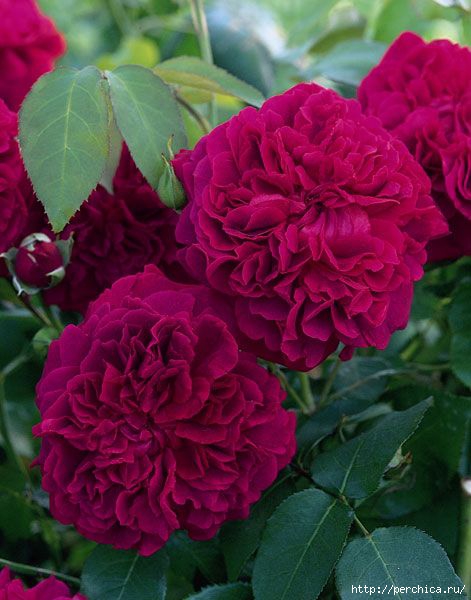
The soil on the site should be well cultivated and fertile. In rainy and damp summers, outbreaks of rose diseases are not uncommon. The infection especially actively begins to develop in a humid and warm environment. The reason for this may also be the thickening of the bushes. Roses need to be thinned out regularly so that the lower foliage can dry out after rain or watering.

You need to start fighting diseases at the first sign of their appearance. If this is not done in time, the weakened plant will stop blooming and may not survive the winter. Roses need quite a lot nutrients and micronutrients. Their deficiency leads to diseases and the appearance of pests on plants.
Regular mineral and liquid top dressings improve the condition of the soil, have a positive effect on the development of roses and help them successfully overwinter. However, it should be remembered that an excess of nutrients in the soil also does not lead to anything good. Let's consider which diseases most often affect roses.
Diseases are divided into two groups: non-infectious and infectious.
Non-infectious diseases are diseases that are not transmitted from plant to plant and arise as a result of adverse conditions environment. So, with a lack of moisture, the plants wither, when the roots get stuck on the leaves, yellow spots may appear, subsequently the leaves turn brown and fall off, root system dies and the plant dies.
An important factor is the regime of mineral nutrition. So, with a lack of nitrogen, the leaves turn pale, shrink and fall prematurely, flowering worsens.With a lack of potassium, young leaves turn red, dry out at the edges and fall off.Leaves turning yellow is a sign of iron deficiency.Small leaves, dark green above and reddish below are symptoms of phosphorus deficiency.
Magnesium deficiency is manifested by the death of tissues along the central vein of old leaves, which fall off prematurely. Chlorosis between the veins is a sign of manganese deficiency.To maintain the balance of minerals, it is necessary to apply specialized fertilizers for roses in spring and autumn.An excess of nitrogen can cause the growth of strong shoots that do not produce flowers (fatty shoots). Such shoots need to be shortened by 1/3, which will serve as branching and the formation of flower buds.
If possible, it is useful to do a soil analysis in a specialized laboratory and get recommendations on the application of the necessary fertilizers.
Infectious diseases are divided into fungal, bacterial and viral.
Fungal diseases
powdery mildew

The causative agent is a fungus Sphaerotheca pannosa. The first feature- the appearance on the leaves, stems and buds of a white powdery coating. Over time, this plaque becomes denser, acquires a grayish color, black fruiting bodies of the fungus appear on it. The spores are easily carried by the wind and can infect other plants. Defeat powdery mildew extremely adversely affects the condition of the plant. The decorative effect is sharply reduced, the affected leaves and buds curl, dry up and fall off, the shoots bend and die.
Powdery mildew can develop even in dry and warm weather. Diseases are susceptible to non-resistant varieties and roses growing in the shade.
Control measures: at the first signs of the disease, treat with systemic fungicides, while changing the preparations so that addiction does not occur. So, for example, Topaz or Skor can be alternated with Quadris or Fundazol. Processing is carried out every 10-14 days until the signs of the disease disappear.
In autumn, all damaged leaves and shoots must be burned.
leaf spot
Several diseases related to spotting are known: black spotting, peronosporosis (downy mildew), cercosporosis (grayish spotting), phyllosticosis, brown spotting, purple spotting and others. The most dangerous and common are black spot and downy mildew.
We will discuss their characteristics below.
black spot

Causative agent: fungus Marssonina rosae affects leaves, sometimes green shoots. The disease is manifested by the formation of small spots on the upper side of the leaves, which then grow, become almost black. Affected leaves curl and fall off, only bare shoots remain, plants weaken, grow poorly, do not bloom. Severe infection can lead to the death of the plant.
Control measures: alternate treatment with systemic fungicides containing different active ingredients. For example, Topaz or Skor alternate with Ridomil Gold or Quadris with an interval of 10 - 14 days. The number of sprays - 2-3 times.
Downy mildew (Peronosporosis)
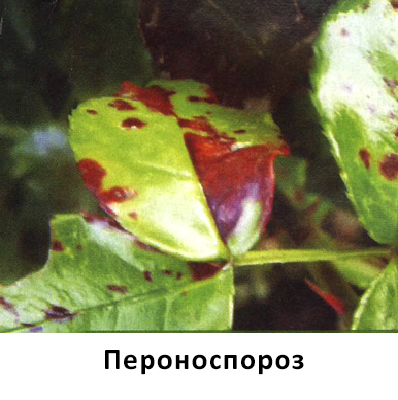
The causative agent is a fungus Pseudoperonospora sparsa.
The initial stages of the development of the disease resemble black spot. Young leaves are covered with brown-violet spots, which can go on the shoots. On adult leaves, areas with a pale color first appear, then they turn brown, dry out and fall off. On the underside of the leaf, a grayish coating can be seen.
Downy mildew can be distinguished from black spot by the nature of the fall of the leaves: with downy mildew, they begin to fall from the top of the shoot, and with black spot from the bottom.
Cool, rainy weather promotes the development of the disease.
Control measures: spraying with fungicides (Ridomil-Gold, Fundazol, Skor, Strobi, Quadris, Profit are effective).
Damaged leaves and parts of the plant are removed and burned.
*Other diseases from the group of spotting are similar in their manifestations and are treated according to the same algorithm as black spot.
Rust
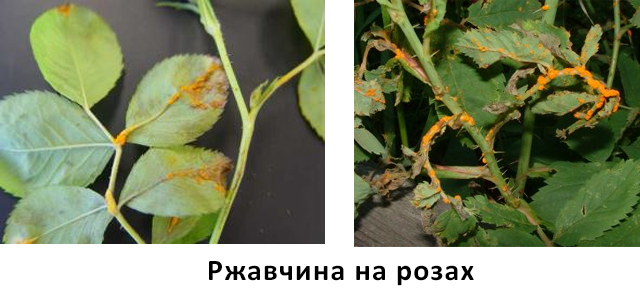
The causative agent is rust Phragmidium disciflorum.
A dangerous disease manifests itself in early summer by the appearance of bright orange tubercles (pycnidia) at the base of young shoots and reverse side leaves, which, growing, become rusty-brown. In autumn, the spots on the outer side of the leaf turn black, and on the underside they become brown-brown. As a result, leaves on diseased plants fall off, young shoots become deformed, crack and dry out. The disease leads to a strong weakening of the plant and even its death.
Control measures: alternate spraying with fungicides with different active ingredients. For example, apply Skor (active ingredient difenoconazole), and then Ridomil-Gold (active ingredient mancozeb). Falcon treatment is also recommended.
Damaged leaves and shoots are burned.
For prevention bushes in the spring are treated with a contact fungicide "Maxim", or Bordeaux liquid (1%).
Infectious burn
![]()
Pathogen - marsupial mushroom Coniothyrium wernsdorffiae.
Symptoms of the disease: in spring, girdle red-brown spots appear on last year's shoots. The bark on such shoots dries up, cracks, ulcers appear on it, infected shoots subsequently die.
The appearance of the disease contributes high humidity in winter shelters and excessive application of nitrogen.
Control measures: spring pruning and burning of diseased shoots, treatment of bushes with Bordeaux mixture, fungicide "Maxim".
To prevent the disease, the following rules should be observed: cover roses in dry, cool weather, remove all leaves and unripe shoots before sheltering, ventilate shelters during winter thaws, open bushes in a timely manner in spring, use disinfected tools for pruning.
Gray rot or botrytis

The causative agent is a fungus Botrytis cinerea. Symptoms: brown spots without bordering with a gray coating of sporulation of the fungus on leaves and shoots. When spores hit the petals, small spots first appear, which grow and turn brown. The flowers rot, covered with a gray bloom.
Wet, cool weather favors disease. If the rules for sheltering roses for the winter are not followed, the disease can severely affect the bushes under shelters.
Control measures: treatment with fungicides (Fundazol, Falcon, Maxim), timely removal and destruction of infected parts of the plant.
Preventive treatment with Maxim, or Bordeaux mixture.
Bacterial diseases
The most common bacterial diseases are root canker and stem canker.
Bacterial root cancer
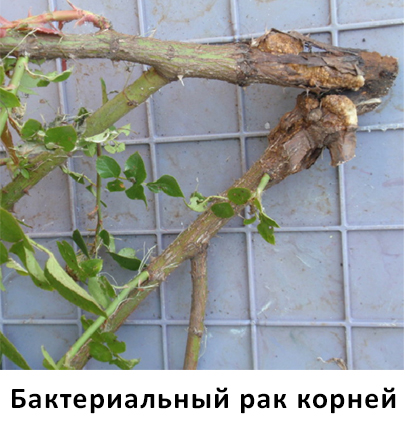
The causative agent is a bacterium Agrobacterium tumefaciens.
Symptoms: dense growths form on the roots and root neck, which rot as bacteria multiply. Affected plants become weak, stunted and eventually die.
Control measures: trimming of the affected parts and disinfection with a 1% solution of copper sulfate. The fight should be carried out in the early stages of the development of the disease, heavily infected plants should be burned.
Prevention: diseased seedlings should be culled; in areas where infected roses grew for 3-4 years, do not plant new bushes, because. bacteria persist in the soil.
Bacterial stem cancer
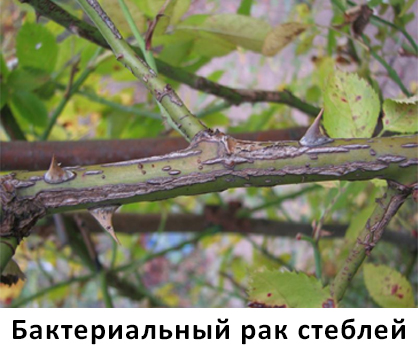
The causative agent is a bacterium Pseudomonas syringae.
Symptoms: first, depressed brown spots appear on the bark of the shoots, then these parts of the bark die off, the shoots gradually dry out. The leaves of diseased plants are covered with dark spots. Weakened plants are susceptible to the disease.
Control measures: removal and burning of infected shoots. Cut the shoots to healthy tissue, disinfect with a 5% solution of copper sulfate, or Maxim, cover the sections oil paint. Severely affected plants should be completely destroyed.
Prevention: spraying bushes in spring (before leaves bloom) and before winter shelter copper sulphate solution or 1% Bordeaux mixture or Maxim.
Viral diseases
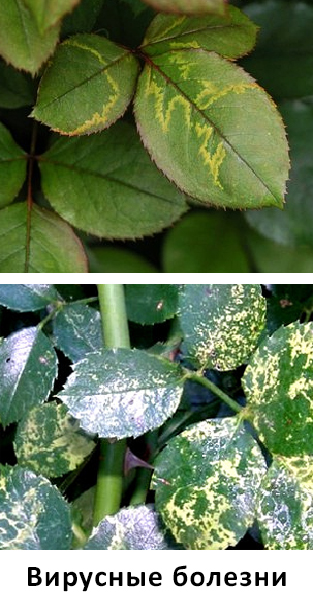
Sometimes on the leaves of roses you can notice the appearance of a pale color in the form of mosaic or ring spots, speckled edging of the veins - all these are signs of plant damage by viruses.
The viral ones are different kinds mosaic diseases, wilting diseases, jaundice, dwarfism, etc.
Viruses can be introduced from planting material, they are spread by insects, as well as through garden tools.
There are quite a few viral diseases, but we will give only the most common ones.
leaf striping
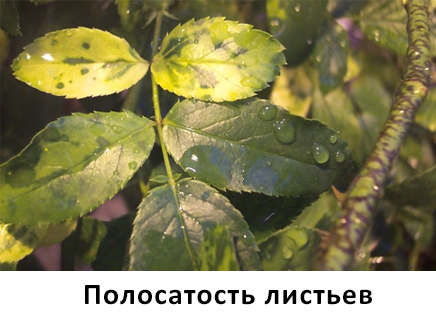
The causative agent is a virus Rose streak virus.
It is characterized by the following symptoms: brown rings and speckled borders of the veins on young leaves, blurry stains and greenish-brown spots on the shoots. Sick plants lag behind in growth, bloom poorly.
Viral wilt
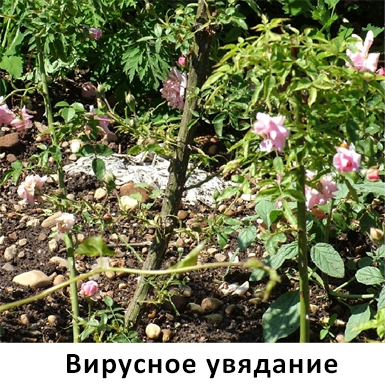
Pathogen - wilt virus roses wiltvirus. Young shoots grow, the leaves become narrow, up to filiform, gradually turn brown and dry. Buds do not form, the bushes lag behind in growth and gradually dry out.
In addition, roses are affected by tobacco necrosis viruses, rhubarb mosaic, apple mosaic, tomato bronze, plum necrotic ring spot and some others. Often plants are affected by two viruses at once.
It makes no sense to mention all possible viral diseases, only specialists can determine them, in addition, there are no effective measures to combat them, therefore, measures are reduced to the removal of damaged parts, or the entire plant in case of severe infection and their subsequent burning. Garden tools after use are disinfected in alcohol or 1% potassium permanganate solution.
Fungal diseases:
Rust
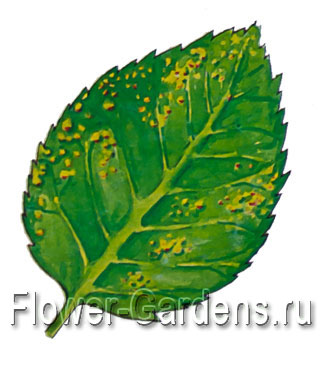
It appears as small rusty, as if powdered tubercles, usually dark in color on the underside of the leaf. Light spots appear on the upper side of the leaf. The leaves turn yellow and begin to fall off early. Fallen leaves must be collected and destroyed, it is best to burn. If the leaves begin to fall off in June-July, spray the underside of the rose leaves every three weeks. blue vitriol.
Gray mold (Botrytis)

Dark brown rot appears on leaves, buds, flowers and stems, and in wet weather - dense white coating. Gray mold primarily affects weakened plants. For prevention, the soil should be loosened in a timely manner, mulched and properly fertilized with roses. Plants affected by gray mold are cut and destroyed.
Cancer, or stem burn
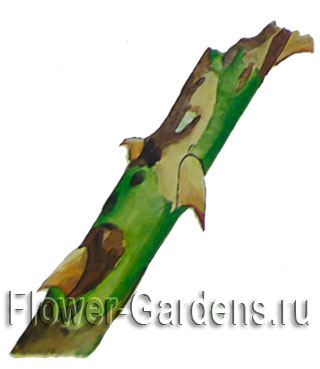
Cancer most often affects the stems of roses under winter shelter in conditions excess moisture. Reddish spots darkening from the center, growing, ring the shoot, which then dies. To prevent this disease in the spring, it is necessary to remove shelters in a timely manner, in spring and autumn, treat roses with Bordeaux mixture or copper oxychloride, cut and remove the affected stems and shoots.
Marsonina
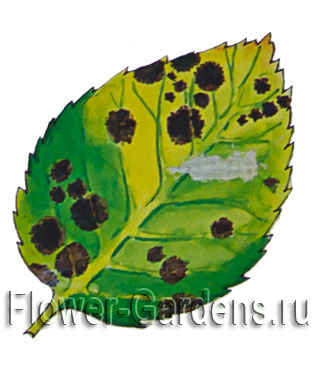
Rounded brownish-black spots with serrated edges appear on the leaves. The leaves turn yellow and fall off early. Fallen leaves should be collected and destroyed immediately. Starting in June, the plants are sprayed alternately with horsetail infusion and blue vitriol. In rainy and humid summers from May to September, roses are sprayed alternately with copper sulphate and copper oxychloride.
powdery mildew
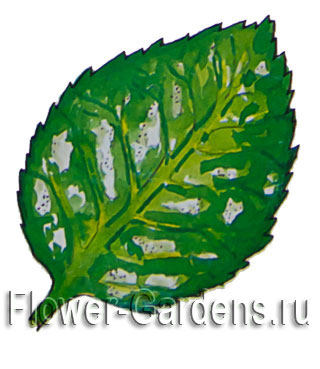
Leaves, stems and buds are covered with a whitish-gray, easily removed bloom, which often appears after sunny days with abundant morning dew. Powdery mildew can be prevented by planting roses in a ventilated area and spraying them regularly in dry weather with a copper-soap emulsion or colloidal sulfur. Sick shoots are cut and burned.
Signs of chlorosis:
magnesium deficiency
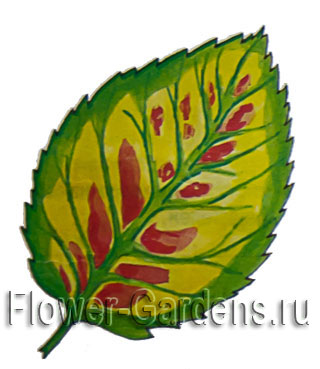
First, signs of the disease appear on older leaves, then on younger ones. Dead, reddish-yellow spots are visible between the veins, the edges of the leaves remain green. After a while, the leaves fall off. Magnesium is necessary for roses for metabolism, sometimes it is not absorbed due to an excess of potassium. Add magnesium sulfate to the soil.
nitrogen deficiency
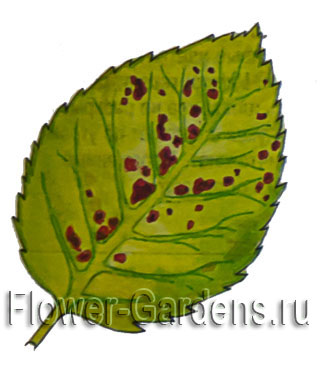
The leaves become light green or yellow, narrow, red dots appear in the middle. Shoot growth slows down. Plants need nitrogen primarily for their growth. Before flowering, roses kick out a lot of leaves. Add fast-acting nitrogen fertilizers for roses, or water roses with herbal infusion.
Phosphorus deficiency
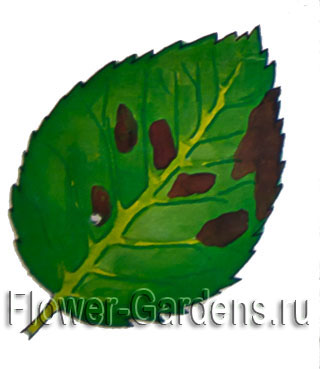
Brown streaks form along the edges of rose leaves. purple tint stripes and spots, leaves fly around earlier, shoots grow weakly. Phosphorus is especially important for bud formation. The lack of phosphorus is often the result of liming of the soil. It is necessary to add peat to the soil, as well as feed the roses with superphosphate.
potassium deficiency
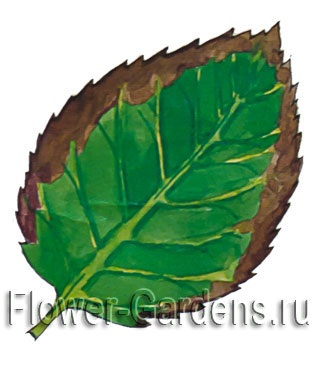
The edges of young leaves turn brown and die. In winter, the shoots freeze, and the rose bush becomes easily ill. Potassium plays a huge role in the maturation of wood. The lack of potassium is caused by an increased content of lime, sand or peat in the soil. For the treatment of roses, it is necessary to apply no later than August to the soil potash fertilizer, better specially designed for roses.
manganese deficiency
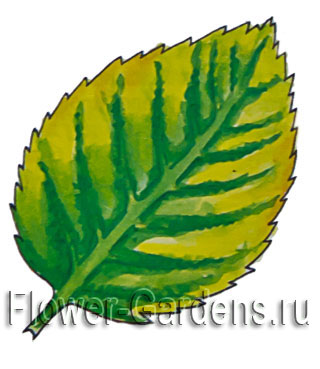
Between the veins of the leaves, starting from the edges and to the central vein, yellow spots extend. Older leaves are most often affected. Manganese is contained in special fertilizers (manganese sulfate, potassium permanganate) that must be applied to the soil.
iron deficiency
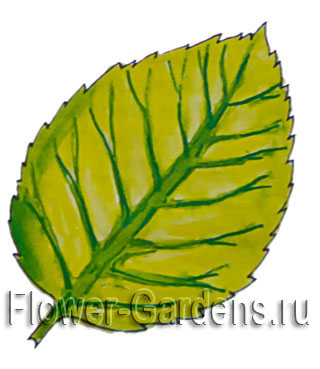
The leaves turn yellow, but their veins remain green. Young leaves turn yellow first. Iron deficiency can manifest itself, for example, with constantly damp or calcareous soil, which makes it difficult for roses to absorb this trace element. It is useful to spray the leaves with a solution iron sulphate or complex organic compounds of iron.
Harmful insects:
rose cicada

The rose cicada first settles on the veins, and then spreads over the entire surface of the leaf. Small insects suck the juices from the underside of the leaves. Most often they appear in dry weather. Affected leaves dry up and fall off. Spraying with pyrethrum helps, and with an increase in the number of pests, treatment with Intavir or a similar preparation is recommended.
spider mite

Small sucking pest (0.3-0.4 mm) greenish-yellow, wintering females orange-red. Ticks settle in large colonies on the underside of the leaves. They multiply very quickly in hot and dry summers and with an excess of fertilizers. Against spider mites spraying with herbal infusions helps well. In dry and hot weather, spray roses more often with water.
rose sawflies
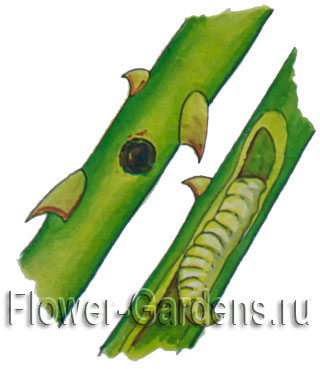
The yellow-green caterpillars of the descending sawfly bite into young shoots in spring and make moves inside from top to bottom. As a result, the shoots die off. In summer, on the stems, you can see holes with a white crumb inside, made from the bottom up by a brownish sawfly caterpillar. Affected shoots are pruned and destroyed.
rose leaf
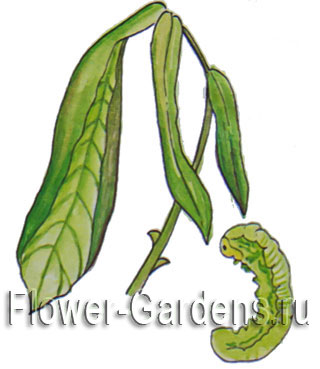
From May, rolled, withered leaves begin to appear. Inside them are small caterpillars with a brownish head. Affected leaves are collected and destroyed. To control insects, it is recommended to attract birds to the garden. With a strong reproduction of leaflets, it is recommended to use chemicals protection, harmless to bees.
rose aphid
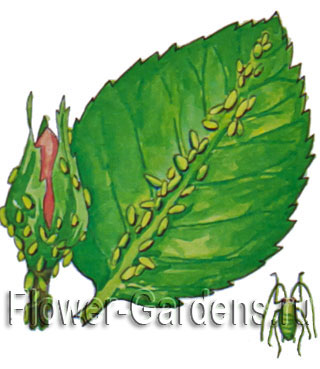
Settles on buds and leaves. The buds do not open and fade, the leaves and young shoots are bent and covered with a sticky mass, and some time later a black soot fungus appears on it. In case of mild infestation, aphids can be washed off with water or wiped with a cloth. With a strong defeat of the rose, it is necessary to spray the plants with an insecticide against sucking pests.
Khrushchi

Golden bronze and garden beetle - small beetles, which eat stamens, pistils and flower petals, penetrate into the buds, which form ugly flowers or their halves. Rose flowers lose their decorative effect or do not open at all. Beetles are collected and destroyed whenever possible. It is better to do it in the morning. Affected shoots are pruned.
Weather
Freezing

Spring frosts at the beginning of the growing season sometimes cause very significant damage to roses. In frozen plants, the edges of the leaves turn brown and dry, and then curl. Bushes do not unravel until the onset of sustained heat. In relatively warm weather, do not forget to water the roses so that they do not suffer from a lack of moisture and do not dry out.
Stagnant water in the soil

The leaves turn yellow, starting from the petiole, and fall off. As a rule, this occurs in damp, heavy, dense soil, and also as a result of excessive watering. Water squeezes air out of the soil, and the roots rot. Plants under such conditions are more likely to be attacked by pests or get sick. In heavy soils, sand should be added and loosened regularly.
[Based on the materials of the magazine "My beautiful garden"]
Finally. To enjoy healthy and beautiful rose bushes in your garden, you need to take care of disease prevention. First of all, roses need to be planted in well-lit and ventilated areas, on rich soils, properly fertilize, treat pests, and prune correctly. For the prevention of fungal diseases in the spring, treatment with the contact action fungicide "Maxim" or a 1% solution of Bordeaux mixture is recommended.
To increase the immunity of plants, treatment with Epin, Zircon, Lignohumate has proven itself.
If you want to have as much as possible less problems with diseases, purchase new, resistant varieties of roses.
rose rust
If dark spots appear on the rose leaves, the plants are probably infected with rust. The causative agent is a mushroom of the genus Phragmidium. You can bring this disease into the garden different ways. On the forums, they are often scared that their proximity to and contributes to the infection of roses, but in fact, the development cycle of rose rust completely takes place on roses, since this is a single-farm fungus. Usually rust enters the garden with new planting material or from nearby neglected bushes. They get sick more often than others, and, but starting with them, the disease can quickly spread to the rest. The development of rust is promoted by high. The disease is more common in heavy and wet soils. The first signs appear already at the very beginning of summer: orange pads, summer spores of the fungus, are visible on the underside of the leaves. Closer to autumn, winter spores appear - the leaves become covered with black spots. The affected shoots are bent, the leaves turn yellow and fall off, the rose stops blooming. If measures are not taken in time, the bush will die over time. The fungus overwinters on fallen leaves and affected shoots.
Rose rust: treatment
At the first time, the plant is recommended to be treated with Bordeaux liquid or any other copper-containing preparations (Abiga-peak, Oxyhom, Hom, Ordan). Sick leaves are collected and burned, damaged shoots are cut below the lesion. In autumn, before sheltering roses, you need to remove all foliage, process them with 3%. It is a pity, but it is better to dig up and burn heavily affected bushes.
Rust control: Julia Tadeusz method
Can you imagine what it means where there are a lot of sick trees around, little sun and a lot of moisture? It would seem that in principle it is not suitable for growing healthy roses. In addition, we often have prolonged rains, which contributes to the development of the whole bunch of diseases. However, my roses look healthy and delight me with both vigor and flowering. All they need is timely and competent care. From my experience, I learned three rules well.

Rule 1: Rust prevention is always better than cure.
Preventing the development of the disease is much easier than treating diseased bushes. first processing ( Hom or Osksihom) my roses are received at the first airing. The next one is in May, the drug Falcon. It is a systemic fungicide of preventive, curative and eradicating action. Active ingredients: tebuconazole, triadimenol, spiroxamine. Thanks to three components, he wide range action, and the risk of addiction to the drug is lower. I completely got rid of not only rust, but also from, it also helps from. It penetrates the leaves within two hours after treatment - this is a big plus when it rains every day. Valid for two to four weeks. If the weather is favorable, one treatment per month is sufficient. An observant rose grower knows from which bushes an outbreak of the disease begins. Gardening only on weekends, I do not always have time to process all the roses, but I always spray those that every year try to become a source of infection for the entire garden. No matter how busy I am, I find time to examine the foliage of roses: not only the top, but also the underside. I immediately cut off all leaves with signs of rust or other diseases. If you have not processed roses yet Falcon, carefully spray, wetting the foliage from all sides. If they feel good, I do the next treatment only at the end of July - beginning of August. And the last rust prevention in the fall, before shelter - I treat roses with a 3% solution of ferrous sulfate.
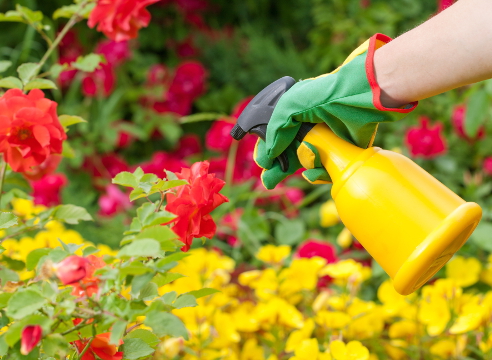
Rule 2. Strong and healthy roses are more resistant to any disease.
I am convinced that the protective mechanism of roses can be increased by a system of top dressing and the use of immunomodulatory and restorative drugs. With the right agricultural technology, roses become strong, disease resistant, grow well, bloom and winter. In the spring, after a formative pruning, I always use urea, 30 g under a bush. After that, until flowering once every two weeks - infusion of chicken manure. During flowering, I do not fertilize, and after the first wave I feed again with infusion of chicken manure. Everything else I give to roses through foliar top dressing. Most of all I like Bona Forte for roses. The composition includes both phosphorus and potassium, which are necessary not only for nutrition, but also to strengthen resistance to diseases, as well as a growth stimulator - succinic acid. I alternate top dressing Bona Forte with spray solution. In addition, a couple of times a season I spray roses with a solution Epina, HB-101 or Immunodeficiency.
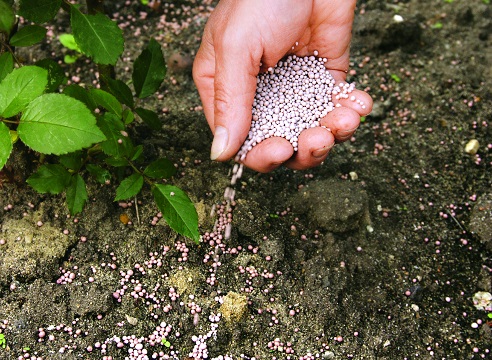
Nettle infusion recipe. Fill a plastic bucket with fresh nettles almost to the top. In order not to filter the infusion later, you can stuff old nylon tights with nettles. Fill the nettle cold water and let it brew for 10 days or more until fermentation is over. Do not cover with a lid, stir from time to time. In the heat, the infusion will ferment faster. For foliar dressings, dilute the infusion with water 1:20, for root dressings - 1:10.
Rule 3. By winter, the garden should be clean.
For many years now I have been cutting off all the foliage from roses and burning it, removing the plant remains of perennials. When I talk about this, sometimes I hear in response: “Last autumn I also cut off all the leaves, but the roses still got sick in the summer.” Of course, by removing the leaves only once, you will not achieve a result - this must enter the system, as well as preventive treatments. That's when you will see healthy and strong roses in your garden, which will generously pay you for your care with friendly and abundant flowering.
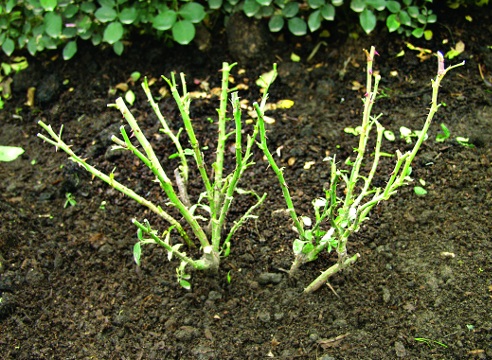
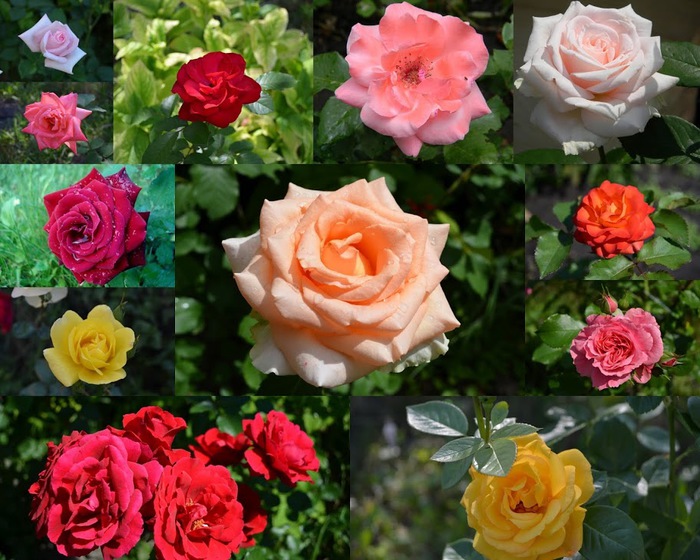
The most common rose diseases and treatments
INFECTIOUS BURN 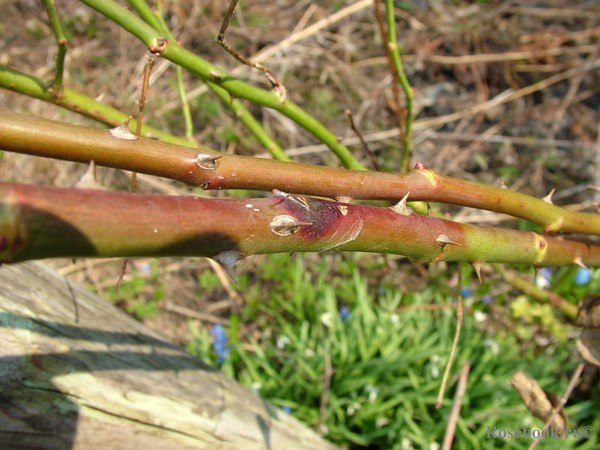
Symptoms. Treatment
Reddish-black spots appear on the shoots, sometimes with a light brown dry area in the center of the burn. A crimson border is visible along the edge of the spot. These spots in the spring with poor ventilation quickly increase in size, ring the shoot, which dries up. 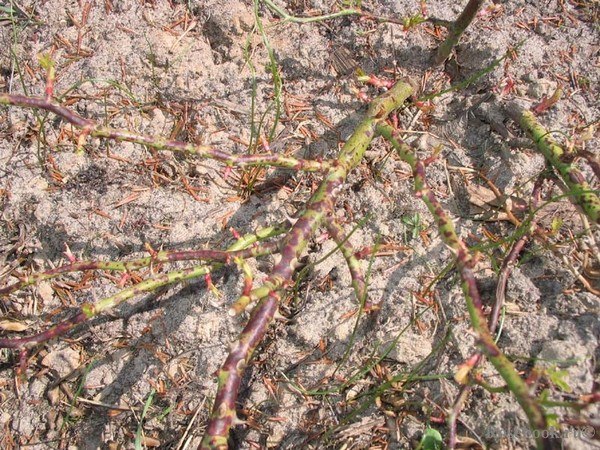
In order to avoid the spread of the disease, it is better to cut off the affected shoots. If the damage is small, and the shoot is very pitiful (for example, in a single-flowering rose), you can try to leave a branch, but watch it very carefully to prevent, for example, damage to the graft - after opening the roses and establishing warm weather, the spread of the disease quickly stops, and burn spots "freeze". Such branches can be pruned after flowering in summer. Such small spots can be tried and treated - cleaned with a sharp knife to healthy tissue and covered with Runnet.
POWDER DEW 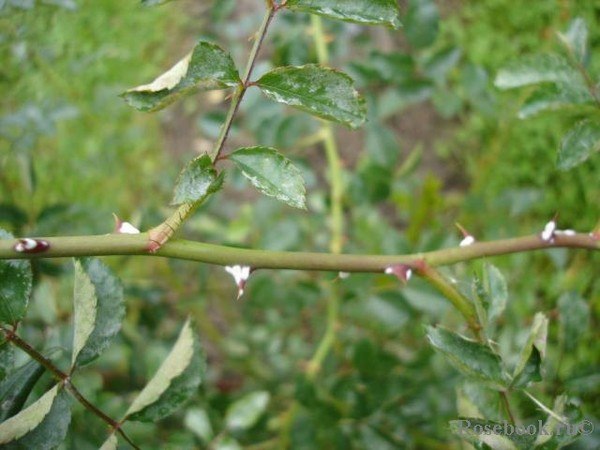
Symptoms. Treatment.
The causative agent is the fungus Sphaerotheca pannosa. Reddish-purple spots appear on young leaves on young leaves, often the leaves are deformed. Buds, shoots, leaves are covered with powdery white bloom, the leaves curl and fall off. Varieties with coarser, leathery leaves sometimes exhibit mosaic coloring or wrinkling. 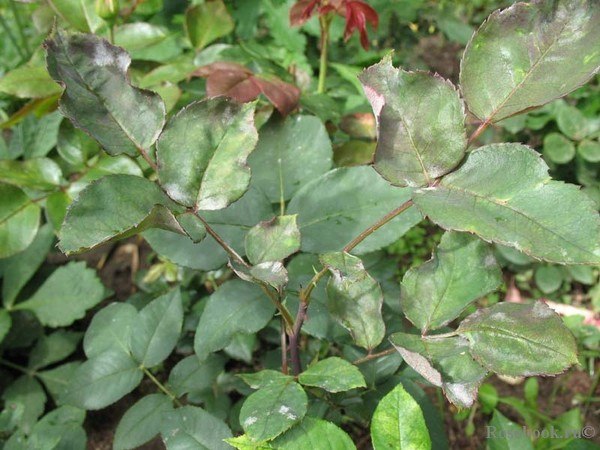
Most fast development fungus and the germination of its spores (conidia) occur at 18-20C and humidity above 60%. Often during the growing season there are 2-3 outbreaks of the disease, which is associated with suitable conditions or re-growth of shoots (powdery mildew affects mainly young tissues). Compliance with the correct agricultural technology - do not overfeed roses, plant in well-ventilated places. Prevention is desirable - roses are regularly sprayed with infusion of mullein or ash (these infusions destroy the threads of the mycelium). For treatment, in addition to the mullein solution, it can be sprayed with triazole-based fungicides (Topaz, Skor).
RUST 
Symptoms. Treatment
The causative agent is fungi of the genus Phragmidium. Rust fungi have several stages of development, the symptoms of damage in which differ from each other. In late April-early May, yellow-orange tubercles of the spring (ecidial) stage of the fungus appear on the stems at the opening buds, on young green shoots, petioles and the upper side of the leaves. Dusty pustules form on the underside of the leaves, from where the spores of the fungus are carried to healthy plants. 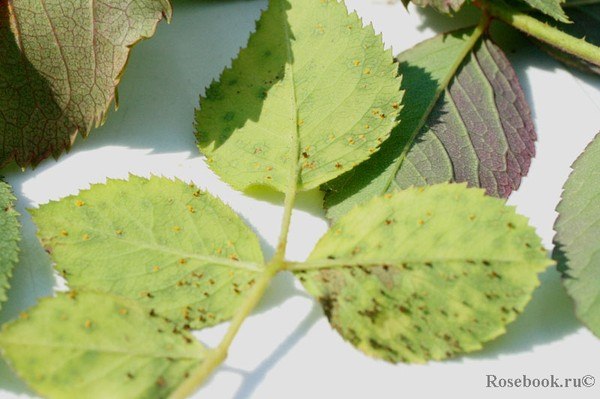
As a result, the leaves turn yellow and fall off, young shoots bend and dry out. In July, the uredostage develops, which is characterized by the appearance of small rusty-brown pustules on the underside of the leaves. Yellow and reddish spots on the upper side of the leaf, growing, cover its entire area. The shoots thicken, deform and crack, which is accompanied by a mass of dusting spores. At the end of August-September, the pustules darken - a tel-tostage develops in them, in the form of which the fungus overwinters in the affected stems and fruits. The last two stages can significantly reduce the growing season of roses, which leads to a decrease in growth, premature drying of leaves, weakening of plants, and in severe cases, to their death. The development of the disease is favored by high humidity, especially in initial period vegetation. Hot, dry weather inhibits the development of the disease. 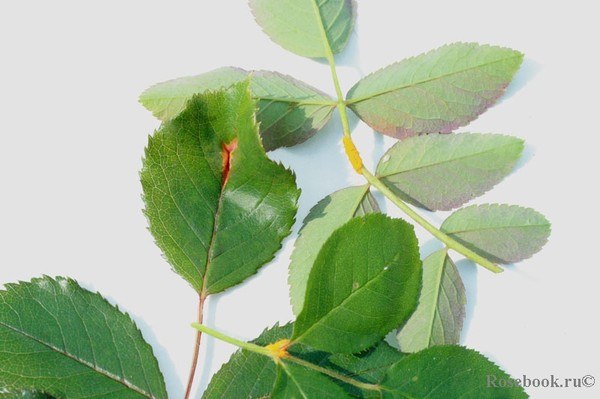
Rust is difficult to treat. It is necessary to cut and burn all the affected parts of the plant - in no case put them in the compost! For prevention, before each flowering, it is necessary to carry out foliar feeding with a 0.3% solution of superphosphate extract and 0.3% solution of potassium nitrate until the leaves are completely wetted. For treatment, you can try alternate treatment with preparations containing mancozeb (Ridomil Gold, Profit) and penconazole (Topaz), as with black spot - but they are also more effective in early spring, as a preventive measure. With severe damage, plants are not subject to treatment. They are dug up and burned.
GRAY ROT 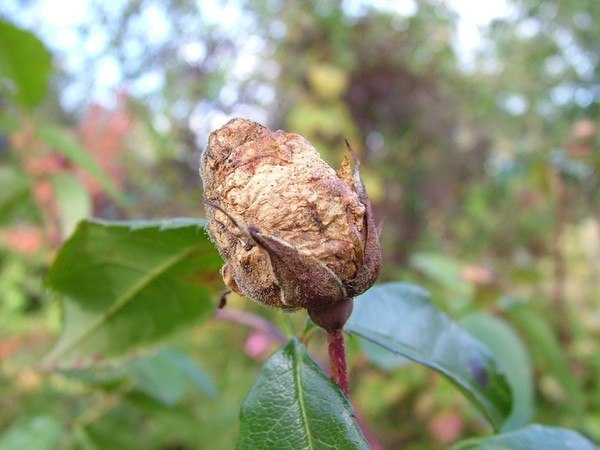
Symptoms. Treatment
The causative agent is the fungus Botrytis cinerea. Wintering shoots of bushes from the side of the upper cut rapidly turn brown from top to bottom and die. At high humidity, the shoots are covered with fluffy smoky gray mycelium. Areas of tissue become brown, and in wet weather become covered with a gray coating. Green shoots dry out completely, flower stems break. Sick buds do not bloom or give one-sided flowers. Densely double varieties are especially affected by gray rot. 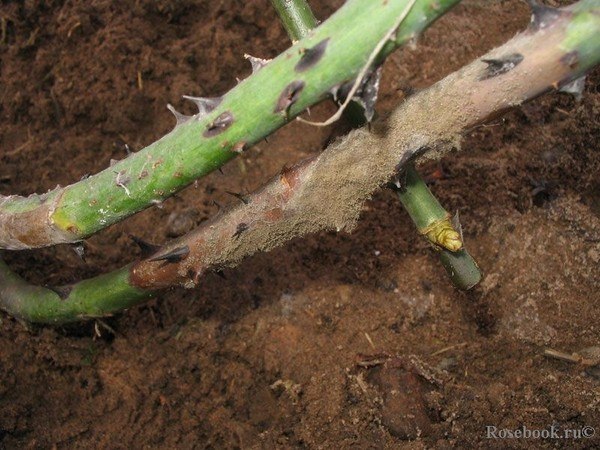
The disease progresses rapidly high humidity air and soil, dense planting, lack of phosphorus and potassium in the soil. At the first signs of the disease, it is necessary to create conditions for maximum dryness next to the plants, feed them phosphorus-potassium fertilizers in a ratio of 2:1 according to the active substance, adding manganese microfertilizers.
BUDDING NOT OPENING 
Symptoms. Treatment
The causative agent is the fungus Botrytis cinerea. Dark spots appear on the stems, the buds and flowers are covered with a dark gray bloom, the outer petals turn brown and dry, the flowers fall prematurely. First of all, rot attacks weakened plants, and most often with white and light pink flowers. Small brown spots (sores) appear on the petals, the leaves turn yellow and also fall off.
The disease progresses in rainy weather, especially among varieties with soft tender petals. 
In order to avoid the appearance of rot on the flowers, roses are not watered by sprinkling, but during the rainy season they are fed with manganese-containing fertilizers, damaged flowers and buds are immediately removed, trying to prevent rotten petals from falling on the leaves. Unfortunately, a number of varieties are susceptible to such flower damage, and in rainy weather you will not be able to see them in all their glory. These are, for example, varieties Colette, Andre le Notre, Eden Rose, Sebastian Kneipp and others.
BACTERIAL CANCER 
Symptoms. Treatment
The causative agent is the bacterium Agrobacterium tumefaciens (Sm. et Town.) Conn. On the roots, root collar, stem bases, uneven tuberculate growths of various sizes appear. 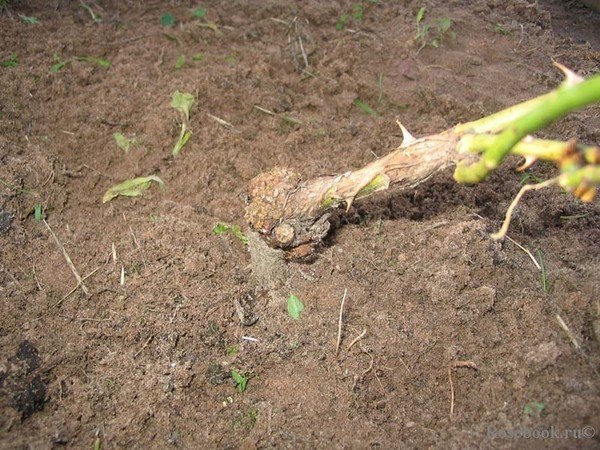
At first they are soft and light, gradually darken and harden, and eventually rot. On the own-rooted roses outgrowths often appear directly on the stems and grow rapidly. In plants affected by bacterial cancer, a weak growth of shoots is noted, and the bushes gradually dry out. Plants with growths in the area of the root collar are dug up and burned. Small growths can be removed with subsequent disinfection with a 1% solution of copper sulphate.
BLACK SPOT 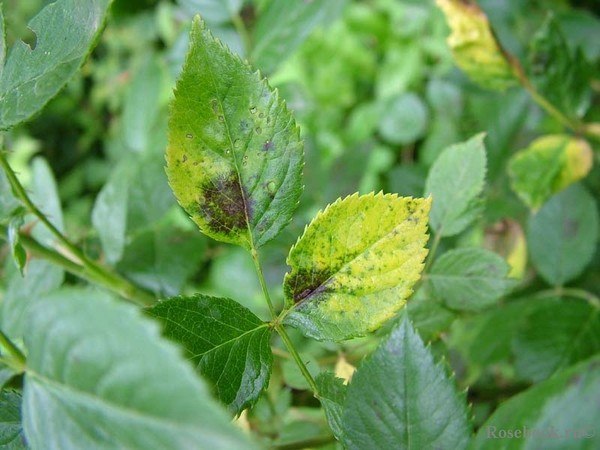
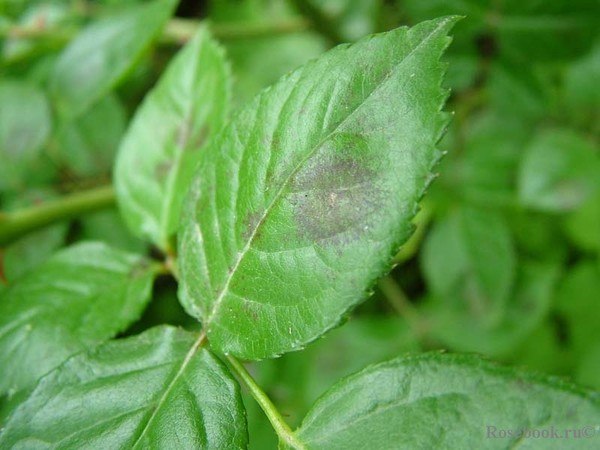

Symptoms. Treatment
The causative agent is the fungus Marssonina rosae. In the second half of summer, black spots appear on the leaves, lower leaves quickly turn yellow and fall off. With a strong defeat, only young unblown leaves remain on the roses. Against this disease, prevention is desirable - spraying with infusions of mullein, horsetail. You can also use drugs that increase the plant's resistance to diseases (zircon, immunophycyte, El, Amulet). Highly good recommendation gave on the Websada forum - for treatment, it is effective to alternate spraying with preparations containing mancozeb (Profit, Ridomil Gold) and triazole (Topaz, Skor), with an interval of a week (alternate no more than three times). Feedback on this treatment regimen is very positive.
DOWN POWDER (PERONOSPOROSIS) 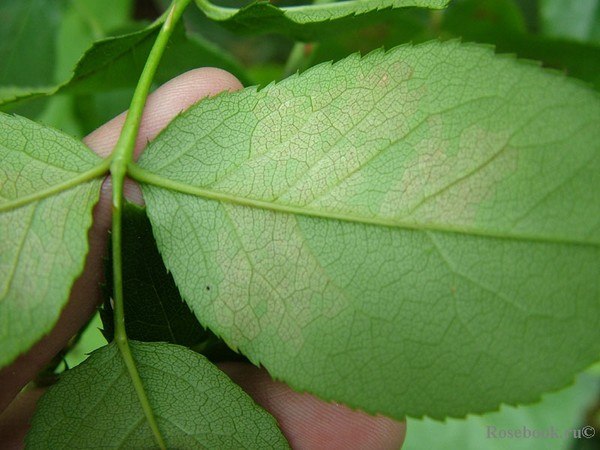
Symptoms. Treatment
The causative agent is the fungus Pseudoperonospora sparsa. The bark of the shoots cracks, becomes covered with "sores". Small red-brown or purple spots of an angular shape (with straight sides of the spot) appear on young leaves, the leaf is gradually deformed. If the spot reaches the central vein of the leaf, it immediately falls off. Purple spots may also appear on shoots. On adult leaves, the leaf tissue becomes faded and soft in places, the color does not change, then this spot quickly becomes red-brown and dries, the leaves turn yellow and fall off, the flowers and buds are deformed. From the inside, a barely noticeable grayish coating sometimes appears (it can often be seen only with a magnifying glass). The outer petals of the buds turn black and fall off. Bushes lag behind in growth. The development of the disease is facilitated by high humidity and cool weather; in dry and hot times, the disease subsides.
Downy mildew is fairly easy to confuse with black spot. The difference is that with downy mildew, the plant usually loses leaves from top to bottom (with black spot - vice versa). At the same time, the fall is very fast, literally in a couple of days.
Affected shoots must be cut and burned (the fungus overwinters in young shoots). The causative agent in biology is close to phytophthora fungi, therefore drugs against phytophthora (Profit, Ridomil Gold) are also effective against downy mildew. As a preventive measure, plants are fed with phosphorus and potash fertilizers.
Leaf cercosporosis (grayish spotting) 
Symptoms. Treatment
The disease is caused by the fungus Cercospora rosiola Pass. Numerous rounded spots appear on the surface of the leaf, 1-5 mm in diameter, initially dirty brown, with a dark purple border. Later, the center of the spot turns gray, and the edging remains dark purple. Sporulation develops on the upper side of the necrotic tissue in the form of black dotted hemispherical pads. Leaves heavily affected by spotting turn yellow and fall off. The disease is easily confused with black spot, which is very similar. Treatment measures are the same as for black spot and downy mildew.
PHYLLOSTICTOISIS OF THE LEAVES 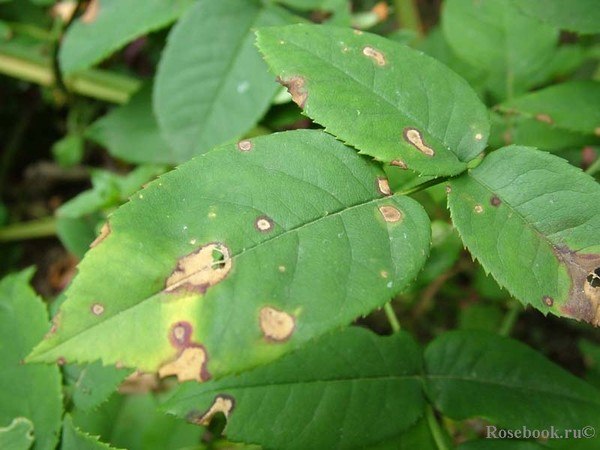
Symptoms. Treatment
The disease is caused by the fungus Phyllosticta rosae Desm. The spots on the leaves are rounded, scattered, dark brown with a wide purple-brown border. Over time, the center of the necrotic tissue becomes ash gray, but a wide purple border always remains. Another fungus, Phyllosticta rosarum Pass., is also often found, causing the formation of grayish-white spots with a wide crimson border. 
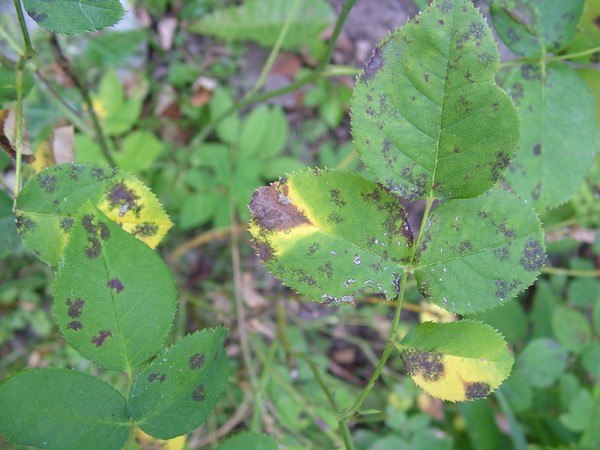
In the center of necrotic spots, small dotted black fruiting bodies of the overwintering stage of fungi are formed. Affected leaves turn yellow and fall off prematurely. The infection persists in the fallen affected leaves. Treatment measures are the same as for black spot and downy mildew.
LEAF SPOT 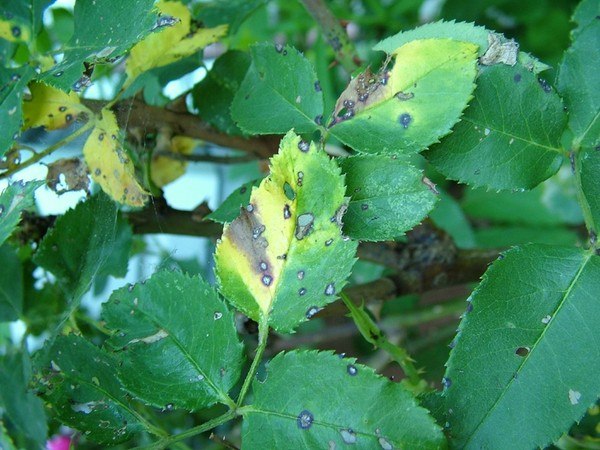
Symptoms. Treatment
The causative agent is the fungus Coryneum confusum Bub.et Kab. brown spots, irregular shape, expanding, and covering the entire leaf, with or without a yellow or red border. Sporulation on the upper side of the leaves in the form of slightly submerged flat blackish rounded beds. The infection persists on the affected fallen leaves. Treatment measures are the same as for black spot and downy mildew.
Pestalotia roses
Symptoms. Treatment
The causative agent is the fungus Pestalotia rosae West. Brown spots appear on the leaves along the edges of the leaf blades, growing towards the middle. On the border of healthy and necrotic tissue, there is often a characteristic yellow stripe. Numerous grayish rounded sporulation pads develop from the upper sides of the spots. Affected leaves turn yellow prematurely and dry out. On young shoots, often in protected ground, depressed necrosis of a grayish-brown color appears, on which sporulation also develops in the form of grayish pads. The mycelium grows into the wood of the shoot, the necrosis deepens, becomes an ulcer. Shoots gradually dry up. The infection persists in plant debris and affected stems. Timely pruning affected branches with cankers, spraying plants on the bark before bud break with Bordeaux mixture or its substitutes (abiga peak). Collection and burning of affected leaves.
PURPLE SPOT 
SymptomsTreatment
The causative agent is the fungus Sphaceloma rosarium (Pass.) Jenk. (=Phyllosticta rosarium Pass., Gloeosporium rosarium (Pass.) Grove.). On the upper side of the leaves, small multiple rounded purple, sometimes even black spots are formed, bordered by a wide crimson stripe. Later, the spots lighten in the center to grayish, but a narrow purple-brown border always remains. Small black fruiting bodies - pycnidia - form on the spots. On the underside of the leaf blade, the spots are brown, merging. Affected leaves fall off, flowers are underdeveloped. With a strong spread of the disease, dark brown spots with a white center appear on green shoots. Treatment measures are the same as for black spot. 
Among the fungal diseases of roses, rust is one of the most common. It is easy to recognize, but it is not so easy to deal with it. What you need to know about the disease and how to prevent its occurrence?
The causative agent of the disease are rust fungi. Their spores are easily picked up by wind currents and can "hover" over a flower garden and other plantings for a very long time. In addition, insects can spread spores.
Signs of rust on roses
Signs of rust damage to plants may vary depending on the variety of roses and the stage of development of the disease. The main feature is bright yellow or orange powder stains, which can be found on the back of the leaves, as well as petioles and, sometimes, buds, fruits and shoots. In conditions middle lane this stage of the disease occurs by mid-June.
By the end of summer spots become darker. This means that the fungus passes into the wintering stage, which will appear again in the spring. controversy stick well to different parts plants, and can also "winter" in the ground, where they fall along with fallen leaves. But the collection and destruction of leaves, although it is a mandatory event, does not fully guarantee getting rid of rust next year.
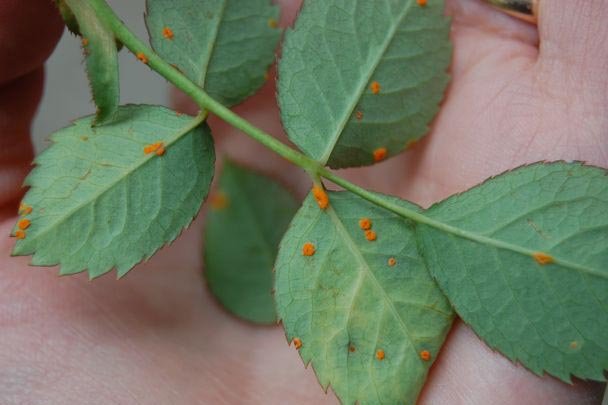
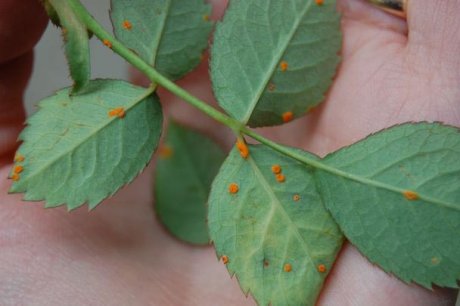
Disease prevention
To prevent infection of roses with rust, it is necessary to inspect all the inhabitants of the rose garden during the summer. If you notice signs of disease on leaves or other plant parts, they should be removed and burned. After that, the roses must be processed fungicides.
In addition, it is important to remember that all roses are susceptible to disease in different ways. Therefore, given the fact that rust is very hardy and spreads easily, it is worth choosing only flowers for your rose garden. highly resistant to rust grades.
Susceptible to rust like normal garden roses, and varieties hybrid tea roses, as well as many new selections. However, planting resistant varieties does not give a full guarantee that roses will not get sick with rust. Even such plants are at risk of infection if good weather conditions favor it.
When choosing disease-resistant roses for your flower garden, try to create conditions for them in which the risk of rust will be minimal. In fact, these are the basic rules for caring for any plants: timely watering, weeding, loosening, top dressing.

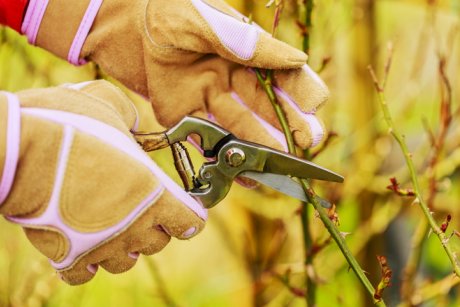
Rust control
As with other rose diseases, rust is easier to deal with in the early stages of the disease by removing damaged parts of the plant. If it was not possible to do this in time, you will have to resort to the use of special preparations.
Spraying roses with copper-containing preparations, such as Abiga Peak or Bordeaux liquid. When treating plants with these agents, it is especially necessary to spray the underside of the leaves carefully. It is these places that are most susceptible to disease and can contribute to re-infection. It should also be borne in mind that these preparations can be washed away by rain, so it is quite possible that you will have to re-treat the plants.
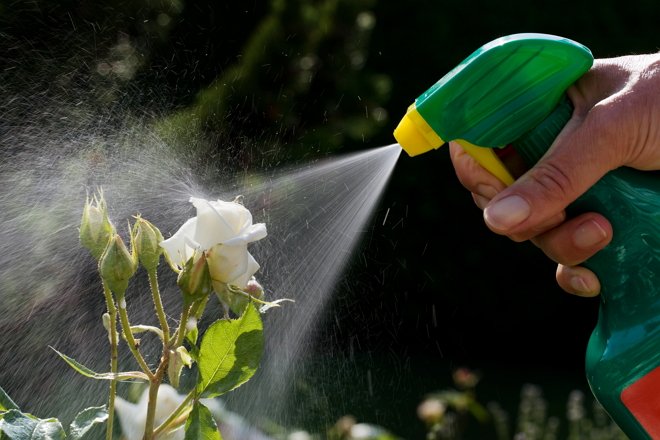
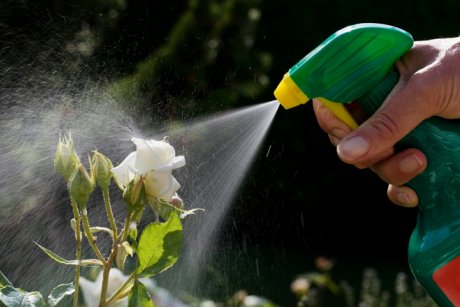
But the drug Topaz not afraid of rain. It fights the spores of the fungus, penetrating inside the plant. In addition, roses treated with the remedy are under its protection for 2 weeks. After that, the processing can be repeated. But, at the same time, this should not be carried away, since a large amount of the drug can lead to a slowdown in the growth of roses.
Remember that any disease is easier to prevent than to cure. Especially when it comes to rust. Try not to let her appear on beautiful roses, and they will delight you with their beauty for more than one season.
The best medicine is prevention
This should be remembered even when buying a plant. We advise you to choose a hardy variety.
Location: For roses, a sunny and well-ventilated place is best suited, where they would not suffer from stuffiness. If the soil is damp, drainage should be done before planting.
Soil preparation: In order to prevent the appearance of pests, roses should be planted in loose soil with good water and air permeability, and the soil should be mulched from time to time.
Top dressing: it is important that it is precisely balanced. An excess of minerals, as well as their lack, weakens the resistance of roses to diseases.
Pruning: The health of a plant depends largely on skilled pruning. Sick, dried and frost-damaged stems should be pruned so that healthy shoots receive more nutrients and develop better.
Combination of plants: The right combination of plants can help in the fight against pests and fungi.
Strengthening plants with natural remedies: the plant is sick - do not rush to take on chemicals. Try to make do with natural methods as long as possible. Natural remedies to strengthen plants, as well as beneficial organisms living in the garden can sometimes work a real miracle.
Plant protection products: if this does not help, biological products, which can be purchased from specialized stores, and, in case of emergency, chemical products should be used to control pests.
Fungicides can be used against fungal diseases, against harmful insects- insecticides, against ticks - acaricides. Use only preparations with a selective action directed specifically against diseases or pests, so that they do not harm bees and other beneficial insects. When purchasing a drug, find out everything about it.
rose diseases
The more closely you monitor your roses, the sooner you will find pests or recognize a disease - this will allow you to deal with it more effectively.
Fungal diseases of the rose
Gray rot: affects buds, flowers, leaves and shoots. After some time, a light gray coating forms on them, as well as brown decaying areas, which lead to the death of the affected parts of the plant. The diseased plant is sprayed with a decoction of horsetail, the affected parts are cut and destroyed.
Viral diseases of roses
Most viruses enter the plant through harmful insects or when pruning with insufficiently clean tools. When affected by viral diseases, flowering becomes less abundant, the growth and development of the plant slows down, the leaves brighten. To prevent these diseases, tools should be thoroughly disinfected, insects that serve as carriers of viruses should be fought; affected plants should be destroyed.
Rose pests
Common pests and diseases of roses
With an optimal location, roses become more resistant to diseases and pests. However, even the most hardy varieties grown on good soils are not immune from them. Unfavorable weather conditions, such as wet summers or extended dry periods, further contribute to the occurrence of diseases. In the early stages of the disease or the appearance of pests, it is difficult to notice them. That's why it's important that you inspect your roses regularly. Only in this way can you help them in time.
| Rose Disease - Black Spot Symptoms: Black spots appear on the upper side of the leaf. Leaves turn yellow and fall off. The plant becomes weakened, new shoots cannot develop and prepare for winter. Causes: a fungus that gets on the leaves or roots with insufficient feeding and excessive moisture Control measures: it is preferable to plant hardy varieties; top dressing should be balanced; affected leaves should be removed and destroyed; plants are treated with decoction horsetail; once every ten days, spraying with sulfur-containing agents is carried out. |
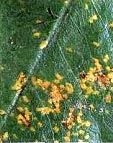 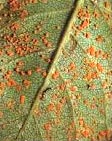 Rusty spots on rose leaves Rusty spots on rose leavesSymptoms: on the upper side of the leaf appear rust spots; on the bottom - bright orange pads - pustules (accumulation of fib spores), which turn black by autumn; leaves fall. Reasons: dry and hot weather. Control measures: treatment with a decoction of wormwood and horsetail; the affected leaves are destroyed. |
 Rose pest - Powdery mildew Rose pest - Powdery mildewSymptoms: gray powdery coating on the upper and lower side of the leaf, shoots and buds. Affected leaves curl. Shoots do not ripen. Plant growth slows down. Causes: fungi develop with excessive feeding with nitrogen-containing fertilizers and stuffy weather. Control measures: choose well-ventilated places; treatment with a decoction of horsetail or nettle infusion. In autumn, affected shoots are pruned and destroyed. If necessary, once every 10 days, roses are sprayed with preparations against powdery mildew. |
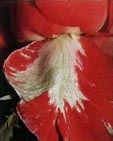 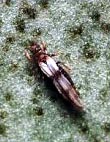 Rose pest - Thrips Rose pest - ThripsSymptoms: Silver spots appear on the leaves and petals of flowers, often black at the edges. The kidneys do not bloom well and are deformed. Causes: The spread of tiny insects is facilitated by dry and warm weather. Control measures: all affected parts of the plant are removed and destroyed. |
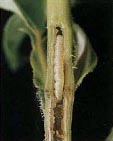 Rose Pest - Sawfly Rose Pest - SawflySymptoms: individual shoots droop, the leaves dry up on them, the shoots die off. Reasons: in spring, the rose sawfly lays eggs at the end of the shoot or in the axils of the leaves. Whitish larvae about 15 mm long appear. They penetrate the shoot and move down (descending) or up (ascending sawfly) (see photo above). Control measures: the affected shoots are cut to healthy wood and burned before the larvae start to emerge from them. Birds help a lot in the fight against sawflies, so it’s good to arrange a birdhouse nearby. |
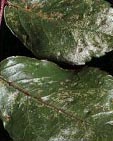 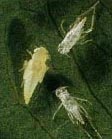 Rose Pest - Chopped Cicadas Rose Pest - Chopped CicadasSymptoms: White spots and specks appear on the upper side of the leaf. The leaves dry up and fall off. Often found in roses growing in a dry and warm place. Causes: greenish insects (see photo) on the underside of the leaf along the veins, suck out the cell sap. Control measures: the leaves are well sprayed with insecticide. |
 Rose Pest - Leaf Rollers Rose Pest - Leaf RollersSymptoms: individual leaves roll up into a tube and die. Reasons: female leafworms lay eggs in May along the edges of the leaves, which then curl up into a tube. From them, whitish or light green larvae appear (see photo above). At the end of July, they reach a length of about 9 mm. Control measures: With a weak lesion, individual infected leaves are torn off and destroyed. In case of severe damage, the plant is sprayed with pyrethrin-containing preparations. In this case, pay attention to the underside of the sheet. |
Natural Ways to Strengthen Plants
Diseases and pests of roses can be dealt with biological methods. Many corresponding preparations have already appeared on sale. However, you yourself can prepare a decoction or infusion and use it successfully. Below are some of these recipes.
Horsetail decoction
It strengthens plant tissues and helps well against powdery mildew, rust and the notorious red spider mites. Preparation: put 1 kg of fresh or 150 g of dried horsetails in a wooden or plastic vessel and pour 10 liters of cold water. Leave it all to infuse for 24 hours. Then, covered with a lid, boil over low heat for 30 minutes to release silicic acid. Then remove the lid and let cool. Strain and pour into a wooden or plastic container. For spraying, the broth is diluted with water in a ratio of one to five.
Use: for prevention, the entire plant is sprayed on especially hot days before the onset of heat (then the action of the decoction is most powerful). In addition, the roots are also watered with decoction. If necessary, the procedure is repeated after a few days.
Important: the decoction retains its properties only for two weeks. When fermentation begins, the broth is used only for irrigation (for this, 1 liter of broth is diluted in 10 liters of water).
Our advice: do not keep the decoction in metal utensils because the acid will corrode it.
Nettle infusion
It is a good top dressing and enhances the resistance of the plant. Due to this, the outer tissues of the plant become stronger, which better protects it from harmful insects. Preparation: 500-700 g of fresh or 200 g of dry nettle are placed in a wooden container and pour 5 liters of cold water. Let it brew for 14 days. Stir daily until fermentation begins. In order to reduce the smell of fermentation, add a little drilling flour. Filter. When used, it is diluted with water in a ratio of 1:10. Another way: make an extract from nettle infusion.
The mixture is left to infuse for only 12-24 hours (no more than 3 days). That is, they are not brought to fermentation, but used immediately.
Usage: infusion is used for watering and spraying the leaves. To combat aphids, the plant is sprayed with an undiluted extract of nettle infusion. Note: nettle powder can be purchased in specialized stores. My advice: mix a decoction of horsetail and nettle infusion - then their action will intensify.
soap solution
It is used to control aphids.
Preparation: take 150-300 g of pure liquid soap and dilute it in a bucket with 10 liters of hot water. Cool. Usage: spray the plant with an undiluted solution.
Soap-alcohol solution
Preparation: Dissolve 200 g of liquid soap in hot water and diluted in 10 liters of hot water. Then add 300 ml of denatured alcohol and mix.
Usage: This solution is used for spraying plants.
Biological means of combating fungal diseases
Those who do not want to "mess around" can purchase the appropriate ready-made products in specialized stores. However, when buying, you need to pay attention to what effect they have on environment.
The most reliable: horsetail concentrate. Thanks to the silicic acid contained in it, it increases the resistance of roses to fungal diseases. Soy lecithin preparations can be used selectively for powdery mildew.
Low environmental impact: preparations containing wettable sulphur. They are made from ground herbs such as nettle, horsetail, onion, seaweed, or powdered silica, and 24 percent wettable sulfur. They are used to control downy mildew and black leaf spot. However, spraying with preparations containing wettable sulfur also harms beneficial animals, such as predatory mites, natural enemies of spider mites.
Important: preparations containing copper also help in the fight against fungal diseases. However, they have a harmful effect on the environment, so it is not recommended to use Bordeaux liquid(or copper-lime mortar) and copper chloride.
 Decoction, infusion of wormwood
Decoction, infusion of wormwood
It is used to control aphids, caterpillars and rust and enhance plant resistance.
Preparation: 300-500 g of fresh grass or 30 g of dried wormwood leaves are poured into a wooden tub with 10 liters of cold water.
Insist: 14 days until fermentation begins. One part of the broth is mixed with ten parts of cold water.
Usage: for watering and spraying leaves.
Another option: wormwood is poured with cold water, insisted for 24 hours (within 3 days), without waiting for fermentation. This hood is used in the spring.
Spraying a rose
With a small population of aphids, beneficial insects that live in the garden will do just fine.
When using plant protection products, safety precautions must be observed.
When spraying, pay attention to the following:
Do not spray open flowers.
Spray well on the underside of the leaf, where pests or fungus can also be found.
The concentration of the solution must be strictly defined - this applies to all biological products.
Spraying is best done in a mask and gloves so that the liquid does not enter the inhalation tract.
Plant protection products should be stored in tightly closed containers out of the reach of children and pets.
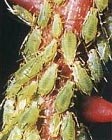 Rose pest - Aphid Rose pest - AphidSymptoms: Buds, stem tips, and undersides of leaves are damaged and lack nutritional juices. Aphids contribute to the spread of viral diseases. Causes: dry weather, excess nitrogen-containing fertilizers. Control measures: the plant should be provided with an influx fresh air, observe the dosage of nitrogen-containing fertilizers. If you find the first individual aphids, destroy them. Affected leaves or shoots are destroyed. The plant is sprayed with soapy water or nettle infusion. Chemicals used when absolutely necessary. |
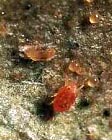  Rose pest - Spider mite Rose pest - Spider miteSymptoms: The surface of the leaf is covered with yellow speckles that turn brown. A web is visible on the underside of the leaf. Reasons: the tick sucks the juice. Control measures: do not plant roses in a sunny place. Watch out for predatory mites. Treat the plant with a decoction of horsetail, as well as acaricides. |
 Rose pest - Shchitovka Rose pest - ShchitovkaSymptoms: scale insects are firmly fixed on plants and suck the juice out of them, leaving a sweetish discharge. A fungus settles on them, causing sooty plaque. Plant development slows down. Causes: scale insects appear in dry or wet areas. Control measures: you should carefully choose a place for planting a rose and protect the natural enemies of the scale insect. The shield is cleaned with a brush or stick. The plant is sprayed with paraffin or mineral oil, which covers the scale insect with a film, so that it becomes unable to breathe. The last resort is to use insecticides. |
Insects that help in the fight against rose pests
Your roses are infested with pests. What to do Don't worry and leave them to their natural enemies first. As long as they successfully deal with pests, you should not interfere. The most important of these beneficial little ones are ladybugs, predatory mites, lacewings, and hoverflies. They are enemies of spider mites, aphids and scale insects. When using plant protection products, remember that they destroy not only pests, but also beneficial insects, deprive those who will survive of food.
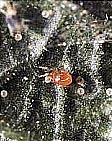 Benefit: it is an enemy of spider mites, especially the red spider mite (photo above). A predatory mite sucks out the testicles of the "red spider". Appearance: Juveniles are yellow, becoming reddish with age and then brown. Pear-shaped body, smooth and shiny. Lifestyle: milky-white eggs are laid in the axils of the leaves along the veins of the leaf. As a shelter, you can offer them strips of fabric in several layers (for example, nylon stockings), which are wound around thick branches in different places in the garden. |
 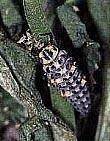 Benefit: eats aphids and scale insects, spider mites; its larvae are especially voracious. Appearance: beetle, semicircular in shape, coloring, as a rule, bright or spotty. Lifestyle: lays eggs on the underside of the leaf or under the scale insect shell. Winters under fallen leaves, etc. |
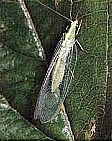 Benefit: lacewing larvae eat aphids, spider mites. Appearance: greenish insect with large golden eyes. Larvae are yellow-brown, on the sides - partially with brown longitudinal stripes; with strong gnawing-sucking mouthparts. Lifestyle: lacewing eggs are laid individually or in groups on any surface, often near a colony of aphids. For protection from other predators, they are strung on long secretory threads. They hibernate in some place protected from frost and wind in the garden or indoors. |
 Benefit: larvae exterminate aphids. Appearance: black and yellow stripes stand out on the back of the body, which is why they are often confused with wasps and killed. The color of the larvae is greenish or yellowish. Lifestyle: You can attract these insects to your garden with herbs such as parsley, cumin, or coriander (cilantro), as well as plantain varieties with yellow flowers. Hoverflies lay their whitish eggs singly, near large colonies of aphids. The loosened soil around a tree or bush can serve as a winter apartment for them. |
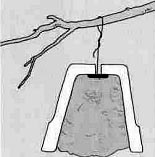 Earwig Earwig This insect is about 2 cm long with a brownish body and claws at the back. They are very useful for roses, as they eat aphids at night. During the day, they usually hide under fallen leaves or rocks. You can create an artificial shelter for them by hanging them from a branch. drainage hole up flower pot filled with loose wood wool. In the spring, the pot is removed and, after changing the wool, is hung up again. During the winter, earwigs hide in the ground. |
Beneficial insects and living organisms
They are attracted to the garden by pests that serve as food for them.
Provide them with shelter, such as loose soil around a tree, piles of fallen leaves, or birdhouses.
Avoid over-feeding: excess nitrogen-containing fertilizer leads to an increase in the number of aphids. Their natural enemies may not be able to cope with so many pests. The most common beneficial living organisms: these include the ladybug, lacewing, hoverflies and predatory mites, as well as the earwig.
Wasps lay their testicles directly in the testicles, larvae or pupae of other insects. The larvae emerging from them eat insects from the inside. These insects are very effective in the fight against aphids. Riders overwinter under bark scales, moss and grass bushes; a good shelter for them is wooden blocks with drilled holes.
Our advice: after cutting, inspect the cut material. If you find darkish remains of aphids with ichneumon larvae hibernating in them, collect them and transfer them to some protected place in the garden.
Ground beetles are nocturnal and eat caterpillars, aphids and mites.
Birds also exterminate insects, ticks, caterpillars, moths.
Other methods of pest control should be resorted to only if beneficial insects or birds living in the garden cannot cope with them. There are many biological products on the market that do not harm the environment. They can be used against spider mites, scale insects and aphids.
Important: pyrethrin - containing preparations are considered biologically harmless. However, they kill not only pests, but also beneficial insects such as ichneumons and ladybugs. Pyrethrin is extremely toxic and, if it enters the bloodstream, causes damage to the nervous system. When working with it, be careful and wear gloves, especially for cuts, abrasions or a tendency to allergies. Pay attention to the instructions for the use of drugs
Diseases of roses caused by improper feeding
For normal development, roses need a certain amount of minerals. Improper feeding leads to plant disease.
Nitrogen:
Disadvantage: weakened shoots, pale green young leaves; red dots on the upper side of the sheet; falling leaves. Fertilize with liquid or special nitrogen-containing fertilizers.
Excess: explosive growth, soft stems; weakening resistance; risk of infection with powdery mildew. From the end of July, they stop applying nitrogen-containing fertilizers (for slow-acting fertilizers, this period comes even earlier).
Phosphorus:
Disadvantage: weak shoots, leaves brownish-violet along the edges; leaf fall; fewer fruits. Fertilizing should be done with liquid or special phosphorus-containing (superphosphate) fertilizers.
Excess: metabolism is disturbed. The plant does not absorb iron and copper. Fertilize with fertilizers that do not contain phosphorus.
Potassium:
Disadvantage: leaves wither, shoots do not ripen; young leaves become reddish, with brown edges; often seen in roses growing in sandy soils. Feeding should be done with liquid or special potassium-magnesium fertilizers. sandy soils enrich by adding compost.
Excess: developmental delay. Stop fertilizing with potassium or complex fertilizers.
Calcium:
Disadvantage: slower root growth. Introduce dolomite marl, carbonic lime, shell and algal limestone into the soil.
Iron:
Excess: the iron contained in the soil is bound. This can cause chlorosis. Do not apply fertilizers containing calcium.
Iron deficiency (chlorosis): the leaves turn yellow, only the veins remain green; the soil contains too much lime. It should be fertilized with iron-containing fertilizers. Manganese deficiency: yellow streaks between leaf veins; appear on older leaves. Thomas flour should be added.
Magnesium:
Magnesium deficiency: reddish-yellow dying zones appear on the leaves in the center; older leaves fall off. Often occurs in roses growing on acidic soils. Potassium-magnesium fertilizers, bitter salt (magnesium sulfate), thomas flour (thomasphosphate) should be applied.

